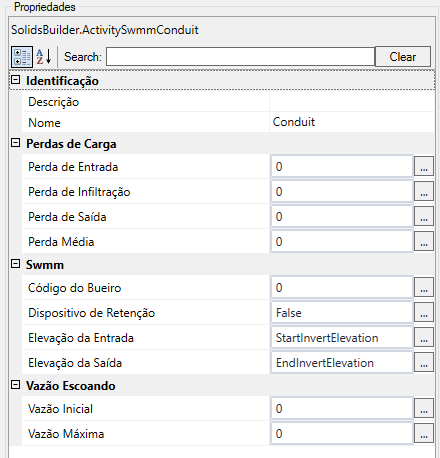SOLIDOS Modeler - SWMM Links - Conduit
The conduits are pipes or channels that move water from one node to another in the transportation system.
When you want to define a device as a conduit, you must add the tool
 Conduit
to the Constructor:
Conduit
to the Constructor:

When adding the tool
 Conduit, fill in your properties, in the tool's properties frame:
Conduit, fill in your properties, in the tool's properties frame:

- Identification
- Name - name of the activity
The point name must follow the naming rules
- Description - when the name of the activity is not enough to give context to the activity, use the description field
- Head Losses
- Entry Loss - Head loss coefficient associated with energy losses at the conduit entrance (typical values)
- Seepage Loss - Optional soil properties that determine seepage loss through the bottom and sloped sides of the storage unit
- Output Loss - Head loss coefficient associated with energy losses at the conduit outlet.
For manholes, use a value of 1
- Average Loss - Head loss coefficient associated with energy losses along the length of the conduit
- SWMM
- Manhole Code - Inlet geometry code number if the conduit is a manhole subject to possible inlet flow control, leave blank otherwise. See the Manhole Code Number Table
Conduits designated as culverts are continuously checked during dynamic wave flow routing to see that they operate under input control, as defined in the Federal Highway Administration publication Manhole Hydraulic Project (Publication No. FHWA-NHI-01-020, May 2005)
- Retention Device - True, if there is a gate that prevents back flow, NOT otherwise
- Inlet Elevation - Elevation of the lower inner generatrix of the conduit
This is a property that depends on the geometry of the conduit, so it must be tied to the starting point of this
- Outlet Elevation - Elevation of the inverted conduit at the outlet end of the conduit
- Flow
- Initial Flow - Initial flow in the conduit at the start of the simulation
Use 0 if not applicable
- Maximum Flow - Maximum flow allowed in the conduit
Use 0 if not applicable
- Cross section
- Hydraulic Section - shape of the hydraulic section, can be of several types:
![]() Conduit
to the Constructor:
Conduit
to the Constructor:

![]() Conduit, fill in your properties, in the tool's properties frame:
Conduit, fill in your properties, in the tool's properties frame:
